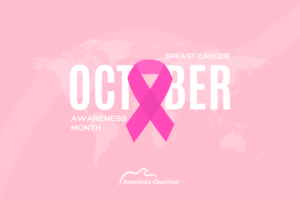October 8, 2025
The Future of Corporate Giving: How Nonprofits Can Prepare
Corporate giving is a valuable part of the nonprofit funding ecosystem. Companies large and small have incorporated philanthropic efforts into their overall business plans, from matching gifts to sponsorships to corporate volunteer programs. But how can your nonprofit more effectively secure these sources of support for your own mission?
This article will address four current corporate giving trends and how your nonprofit can adapt to take advantage of these opportunities. That way, you can maximize support for your cause and build lasting partnerships with charitable businesses.
The Growth of Corporate Volunteering
The Corporate Trend
Offering volunteer time off (VTO) and organizing team-wide volunteer days are some of the most popular ways for companies to support their corporate social responsibility efforts and build morale, and volunteerism is only getting more popular. More and more companies are offering VTO, in addition to sick time and paid time off, as part of their benefits packages.
Volunteerism has a lot of benefits for companies, even beyond the impact that they have for nonprofits in their communities:
- Promoting volunteer opportunities improves retention rates.
- Volunteering can help staff develop their skills in new ways.
- Supporting volunteer efforts deepens company loyalty.
Because employees increasingly want to work for companies that align with their values, volunteerism is going to continue to grow in popularity.
Your Nonprofit’s Response
Strengthen and expand your volunteer program to make it easier for companies to build relationships with your organization and for their employees to have fulfilling experiences.
Consider reaching out proactively to companies in your region with missions aligned with yours to see if you can build long-term relationships. You can also work with them to create volunteer opportunities that work for their schedules, such as one-day projects or weekend options.
Kindful’s volunteer management guide suggests gathering and implementing feedback from volunteers to strengthen your relationships with them. Consider automating regular surveys to collect suggestions from companies or their staff and improve their experiences over time.
Additionally, since companies are interested in volunteerism that strengthens their employees’ skill sets, match volunteers to projects that allow them to use or develop the skills most valuable to them. Leverage your volunteer management system to organize people by skills or interests and allow them to select their own activities.
Building Long-Term Partnerships
The Corporate Trend
Companies in 2025 aren’t looking for one-off donation recipients. Corporations are thinking about the long-term sustainability of their employee workplace giving efforts and are using their corporate purpose to guide their philanthropic efforts.
Employees are also getting more involved with their employers’ actions—they want to know how their donations and volunteering efforts are impacting their communities or the causes they care about. To meet this need and understand their own impact, companies are looking for nonprofits that they can support over a longer period of time.
Your Nonprofit’s Response
Your nonprofit can respond to this desire by being proactive in pursuing these relationships. First, think about the status of your sponsorship program. Do you have a clear understanding of the value that your organization can provide to a corporation? Then, once you have a firm grasp on the benefits your nonprofit can offer, reach out directly to those aligned with your mission, values, or goals. For example, an environmental conservation nonprofit might partner with a gardening supply or landscaping company.
Additionally, consider ongoing opportunities for companies to lend their support long-term. For instance, let’s say you host a fundraising 5K each year. After a company successfully sponsors your event for the first time, you may develop a sponsorship contract in which they support that specific event for years to come.
Increasing Matching Gifts
The Corporate Trend
Matching gifts are one of the most underutilized but potentially powerful donation mechanisms for corporations. In response to an increased desire from their employees for transparency, flexibility, and accountability, corporations are expanding their matching gifts programs.
More Russell 1000 companies offer matching gifts programs—an increase of 12% over the last three years. Other companies are lowering minimum donation and increasing maximum donation amounts, which makes it easier for employees to donate at the size that’s right for them.
Additionally, the One Big Beautiful Bill, signed into law on July 4, 2025, includes a provision, effective after 2025, allowing non-itemizers to take a charitable deduction of $1,000 for single filers and $2,000 for taxpayers who are married and filing jointly. This new law adds some motivation for donors to participate in their company’s workplace giving and matching gift programs, whether they itemize or not.
Your Nonprofit’s Response
In response to this trend, your nonprofit should make it as easy as possible for any individual donor to see if they’re eligible for matching gifts and complete the process. For instance, you may add a matching gift tool directly to your donation page so donors can check their eligibility and send the appropriate forms directly after contributing.
You can also promote matching gifts in your donor stewardship and cultivation efforts. People who have donated to your nonprofit before will appreciate the opportunity to increase their impact on your organization without reaching back into their wallets. However, donors frequently only have until the end of the calendar year to submit their match requests, so make sure you reach out in advance.
Responding to Disaster and Crisis
The Corporate Trend
Many companies are prioritizing disaster relief efforts in response to unpredictable and catastrophic events such as hurricanes or wildfires. This type of philanthropy allows companies to give money to causes that are directly related to the audiences they serve or the regions in which they work. It also supports the mitigation and recovery efforts after these events, which is helpful for both the communities they serve and the company’s public image.
Employees appreciate this type of philanthropy because it allows them to see the values of the company they work for in action and gives them a way to help others in the face of adversity.
Your Nonprofit’s Response
If your nonprofit is involved in disaster response or recovery efforts, proactively include companies in your fundraising or volunteer efforts when disaster strikes. Strategies like creating supporter segments based on how they prefer to participate (financial support, manpower, in-kind donations of food, shelter, or other necessities) and regions of interest can help you leap into action when the time arises.
You can also plan how to best reach out to supporters when time is of the essence. William Paton, the author of Philanthropic Grantmaking for Disasters, stated that, “Over a third of private giving is done in less than the first four weeks of a sudden disaster… and two-thirds within two months.” To take advantage of this narrow window of immediate support, preparation and immediate action are critical.
Consider investing in text-to-give software that allows you to reach donors or volunteers quickly so you’re prepared to facilitate these donations when the worst occurs, or co-creating your disaster response plan with your corporate partners.
Though philanthropy is changing, your nonprofit can prepare for a bright future by anticipating corporate trends and proactively responding to them. Building new partnerships and meeting companies where they are can help you to co-create a healthy ecosystem of organizations all working towards your shared goals.
Get Resources and Insights Straight To Your Inbox
Explore More Articles
Congratulations to Our Members Recognized Among America’s Favorite Charities
Each year, The Chronicle of Philanthropy releases its list of America’s Favorite Charities—the 100 nonprofits that raise the most from individual donors, foundations, and corporate…
Read ArticleJoin Us at the Workplace Fundraising & Volunteering Summit!
We’re excited to announce that America’s Charities President, Jim Starr, and Board Member, Fernando Lorence of JP Morgan Chase, will be speaking at the Workplace…
Read ArticleGet Resources and Insights Straight To Your Inbox
Receive our monthly/bi-monthly newsletter filled with information about causes, nonprofit impact, and topics important for corporate social responsibility and employee engagement professionals, including disaster response, workplace giving, matching gifts, employee assistance funds, volunteering, scholarship award program management, grantmaking, and other philanthropic initiatives.




